 For many, it is a subject anticipated with hesistance.
For many, it is a subject anticipated with hesistance.The reemergence of Batman as a feature film juggernaut has launched the character back into the mainstream zeitgeist. As enthusiasm for the secrets of The Dark Knight slowly fade, attentions turn toward next year's Academy Award nominations, and the prospect of seemingly inevitable sequels.
Robin remains synonymous with Batman for many, particularly the uninitiated, whose familiarity with the characters comes directly from cross media exposure. The sixties TV series, Joel Schumacher films of the late nineties, and cartoon series, remain sticking points.
Despite the continued association, the Robin branch of the franchise has successfully established a strong autonomy. Joining titles like Nightwing and Birds of Prey as an autonomous entity, the solo adventures of the boy wonder have become a selling point unto their own, establishing a gradually removed asthetic, and mythos.
Popular speculation now looks to a third chapter to introduce this voice of innocence into the Batman's increasingly dark world.
I wonder, however, if convention may have many looking to the wrong sources for inspiration.
It is a common misconception, when speaking of film, that sequels need to repeat their precursors but differentiate by getting bigger. In the wake of Heath Ledger's critically acclaimed turn as the Joker, moviegoers have been confronted with a performance many believe can not be topped, bringing this issue to a head. The comic book form has spent upwards of seventy years displaying - to varying successes - the creative form of longevity.
Among his many vices is [Christopher] Nolan's capacity for honoring the source medium.
Despite relative ignorance, Nolan successfully employed the advice of those better initiated (David Goyer), to bring an outsider's perspective that the diehards and neophytes would agree, distills the character and his universe to his finest parts. Hidden within each film, however, are conventions familiar exclusively to the comic book fan, who has become accustomed with reading sequential adventures that further a character's development, but rely exclusively on insular thematics to define an arc.
Both Batman Begins and The Dark Knight depict events tied strongly to conventional themes and storytelling methods, but do so without suggesting definite commitment to filmic escalation.
Should we expect Robin in a sequel?
There's a fair school of thought that after The Dark Knight, there may be a Return, which could very succesfully draw once more on the influences of Frank Miller in introducing a boy wonder sidekick. Others look to the continued influence of Loeb's Dark Victory for more precedent, but I personally feel this hasty introduction was one of the few disappointments of that series.
If Nolan continues as is, there is no reason to attempt to beat himself. It is the hyper-reality of the continued struggles of Batman and Gotham City that provide for us the necessary drive to continue to return. These stories should not be viewed through the meta-textual lens of expectation, instead, digested like comic book storyarcs, satisfyingly contained, despite being part of a bigger, unfolding whole. A whole that needn't interupt it's mature sequence with the four-colour pantaloons of one of Batman's most fantastic characters. There's still a lot of story to tell, psychological wells to plunge within, and plenty of reference for a solo Bat.
However, for your information, a selection of previous features boasting Batman and Robin, together as a dynamic duo:
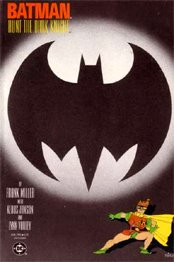 Dark Knight Returns #3 (May 1986)
Dark Knight Returns #3 (May 1986)"Hunt the Dark Knight" Frank Miller
In a grim future where the heroes have been driven away by a cowardly and suspicious society - the Dark Knight returns!
Batman's revolution fuels a dichotomy within the opinions of a modern society torn between the social impacts of a vigilante whose greatest power now seems to be his branding. As a [pop]-cultural phenom, the Batman inspires and protects the weak from a new breed of street tough, the likes of which have overshadowed the once prominent freaks and mobsters.
Inspired when the Dark Knight rescues her from a midnight rendezvous with the Mutant Gang; Carrie Kelly takes up the Robin mantle in an effort to join the war on injustice.
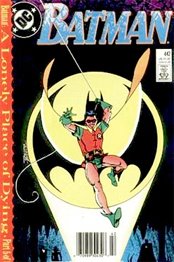 Batman #442 (1989)
Batman #442 (1989)"Rebirth" Wolfman/Perez/Aparo
After the second Robin was beaten to death by the Joker; Batman found himself spiralling downward into an internalized darkness. The absence of his original ward, Dick Grayson, who left his mentor to become Nightwing, only exacerbates the Dark Knight's morose tone.
It is the unlikely influence of an industrious youngster - Tim Drake - who uncovers the secrets of the Dark Knight through keen observation and deduction alone. Concerned for the growing gloom of the Batman's world; Drake makes it his mission to restore the Batman's faith through the presence of a Robin.
When Two-Face becomes a pawn in the Joker's machinations, his attacks on the Batman and Nightwing force Drake to prematurely don the Robin suit to save his hero. It is the first step toward convincing the Batman he is ready to foster a third partnership.
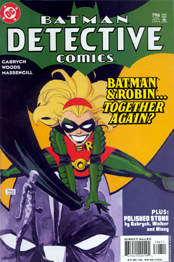 Detective Comics #796 (September 2004)
Detective Comics #796 (September 2004)"... And Red All Over" Gabrych/Woods
When Tim Drake's father discovers his son's heroic alter-ego, the pressures of his threats to expose the team to protect his son, forces the youngster to take leave of his role as the Boy Wonder.
In his absence, it is his vigilante girlfriend, Spoiler, aka; Stephanie Brown, that enthusiastically pledges her allegiance to a reluctant Batman. The Dark Knight agrees to train her as a more efficient force for good, but an impetuousness similar to the second Robin leads Brown down a dark path.
As the new dynamic duo tackle the dangers of Gotham City, Batman grows increasingly frustrated with a Robin so desperate to prove herself, she will eventually spark a gang war that threatens her life.
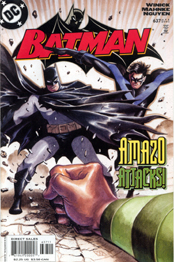 Batman #637 (April 2005)
Batman #637 (April 2005)"Overnight Deliveries" Winick/Mahnke
The Flying Graysons were a spectacular family act of acrobats travelling with the circus, but when mobsters began pressuring the circus, they became the collateral damage in criminal dealings.
Seeing an echo of himself in the vengefully orphaned youngster; Bruce Wayne adopts Dick Grayson and offers him the opportunity to channel his acrobatic training and thirst for justice. As the original Robin, Grayson brings light into the Dark Knight's world for the first time.
Decades later, Robin grows up to be his own hero, and as Nightwing, he continues his war on crime as a force comparable to Batman. Always wrestling with the internal darkness these heroes struggle with, Grayson remains a hopeful mirror to the Dark Knight.
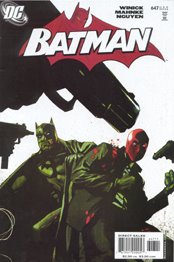 Batman #647 (January 2006)
Batman #647 (January 2006)"The Away Team" Winick/Mahnke
When street kid Jason Todd made an attempt to steal the tyres from the Batmobile, he endeared himself to a Batman whose Robin had flown the nest to become Nightwing.
Batman takes the homeless orphan into his care, but soon discovers Todd to be far more volatile than his former success, Dick Grayson. Together they pursue the blight of crime that grips Gotham City, but in doing so, only expose the new Robin to opportunities to exact an unrelenting brand of justice on his foes.
It is his insolence that ultimately leads to this Robin's death, but when forces beyond the universe exact their will, Todd is shockingly resurrected in his coffin. With no memory of the life he lost, Todd returns to a life without direction, but when Talia Al Ghul returns to him his memory, Todd becomes Batman's worst nightmare as - the Red Hood!

No comments:
Post a Comment